10 Beast Korean Cookbooks for Authentic Recipes in 2024

Annyeonghaseyo(안녕하세요 food lovers! Are you ready to embark on a mouthwatering journey through the vibrant world of Korean cuisine? Buckle up, because we're about to dive into the absolute beast Korean cookbooks of 2024. But first, let me tantalize your taste buds with a little-known fact: Did you know that Korean food has seen a staggering 120% increase in popularity in the U.S. over the past five years? It's no wonder – with its perfect balance of flavors, textures, and health benefits, Korean cuisine is taking the world by storm faster than you can say "kimchi"!
From the sizzling streets of Seoul to the cozy kitchens of Korean grandmothers, the flavors of Korea have captivated food enthusiasts around the globe. Perhaps it's the umami-rich depth of a perfectly aged kimchi, or the satisfying sizzle of bulgogi on a hot grill. Maybe it's the comforting embrace of a steaming bowl of sundubu-jjigae on a cold day, or the playful pop of flavor from a bite of bibimbap. Whatever it is, Korean cuisine has that special something that keeps us coming back for more.
Whether you're a seasoned pro who can fold mandu dumplings with your eyes closed, or a curious beginner who's just dipped their toes into the world of gochujang, these cookbooks will have you whipping up authentic Korean delicacies in no time. So, grab your chopsticks, tie on your apron, and let's dive into the cream of the crop!
But before we unveil our list of the top 10 beast Korean cookbooks, let's take a moment to understand what makes a Korean cookbook truly stand out from the crowd. After all, in a market flooded with options, how do you separate the wheat from the chaff? Or should we say, the kimchi from the cabbage?
What Makes a Korean Cookbook Stand Out?
Authenticity of recipes and techniques:
A truly great Korean cookbook should transport you straight to the bustling streets of Seoul or the cozy kitchens of Korean grandmothers. The recipes should be true to their roots, offering the real deal when it comes to flavors and cooking methods. But what does authenticity really mean in the context of Korean cuisine?
Authenticity in Korean cooking isn't just about following a set of instructions. It's about understanding the soul of the dish – the balance of flavors, the importance of texture, and the role each ingredient plays in creating a harmonious whole. A standout cookbook will not only provide recipes but also explain the principles behind Korean flavor combinations. For instance, the balance of sweet, sour, salty, and spicy in a well-made bibimbap, or the importance of fermentation in developing the complex flavors of kimchi.
Moreover, authentic Korean cookbooks should address regional variations. Korea, like many countries, has distinct regional cuisines. A comprehensive cookbook might explore the seafood-rich dishes of coastal Busan, the royal court cuisine of Seoul, or the hearty, spicy flavors of Jeolla province.
Clear explanations of ingredients and substitutions:
Let's face it, not everyone has easy access to a Korean supermarket. The best cookbooks provide clear descriptions of ingredients and offer practical substitutions for those hard-to-find items. But it goes beyond just listing alternatives – top-notch cookbooks will explain how these substitutions might affect the final dish and how to adjust accordingly.
For example, a great Korean cookbook might not only suggest using miso paste as a substitute for doenjang (fermented soybean paste) but also explain how this substitution might make the dish slightly sweeter and less complex. It might then suggest ways to compensate for these differences, perhaps by adding a touch more salt or a splash of fish sauce to deepen the umami flavor.
Additionally, the best cookbooks will provide guidance on how to select and store Korean ingredients. How do you choose the best gochugaru (Korean red pepper flakes)? What's the difference between dark and light soy sauce in Korean cooking? How long can you keep homemade kimchi? These are the kinds of insights that elevate a good cookbook to a great one.

Cultural context and history:
Korean cuisine is steeped in rich traditions and history. A standout cookbook doesn't just throw recipes at you; it takes you on a cultural journey, explaining the significance of dishes and their place in Korean society. This cultural context adds depth to your cooking experience and helps you appreciate the cuisine on a whole new level.
For instance, a superior Korean cookbook might explain the tradition of Korean holiday foods. Why do Koreans eat tteokguk (rice cake soup) on New Year's Day? What's the significance of songpyeon (half-moon shaped rice cakes) during Chuseok (Korean Thanksgiving)? Understanding these cultural nuances not only enriches your knowledge but also helps you connect with the heart and soul of Korean cuisine.
Moreover, the best cookbooks will delve into the philosophy behind Korean eating habits. They might explain the concept of hansik (Korean food) as a form of medicine, discussing how Koreans have traditionally viewed food as a way to maintain health and prevent illness. They could explore the importance of fermented foods in Korean cuisine, not just as flavor enhancers but as probiotic-rich foods that aid digestion and boost immunity.
High-quality photographs and step-by-step instructions:
We eat with our eyes first, right? Gorgeous, mouthwatering photos can inspire you to try new recipes. Coupled with clear, step-by-step instructions, they can make even complex dishes seem achievable. But the best cookbooks go beyond just pretty pictures.
Top-tier Korean cookbooks will include photos that not only make your mouth water but also serve an educational purpose. They might showcase the ideal color of perfectly fermented kimchi, the right consistency of bibimbap gochujang sauce, or the proper way to wrap and fold mandu (Korean dumplings). Step-by-step photos for more complex techniques, like the intricate pleating of royal court dishes, can be invaluable for home cooks trying to master these skills.
Additionally, some of the best cookbooks include photos of ingredients, especially those that might be unfamiliar to Western cooks. A visual guide to different types of kimchi, varieties of Korean seaweed, or the array of banchan (side dishes) that make up a traditional Korean meal can be incredibly helpful.
Range of difficulty levels:
Whether you're a novice cook or a culinary whiz, a great cookbook should have something for everyone. From quick weeknight dinners to elaborate feast-worthy dishes, variety is the spice of life (and cookbooks)!
The best Korean cookbooks will offer a progression of recipes, allowing readers to build their skills and confidence over time. They might start with simple dishes like dubu jorim (braised tofu) or oi muchim (spicy cucumber salad), then progress to more complex recipes like japchae (stir-fried glass noodles) or dakgalbi (spicy chicken stir-fry). Eventually, they'll guide you through creating a full Korean feast, complete with numerous banchan, soups, and main dishes.
Moreover, top-notch cookbooks will offer variations on recipes to suit different skill levels or time constraints. For instance, they might provide both a traditional, time-intensive kimchi recipe and a quick "emergency kimchi" recipe for when you're short on time but craving that fermented goodness.
Now that we know what to look for, let's dive into our list of the 10 beast Korean cookbooks that will transform your kitchen into a Korean culinary paradise!
Top 5 Beast Korean Cookbooks for Traditional Recipes
"Maangchi's Big Book of Korean Cooking: From Everyday Meals to Celebration Cuisine" by Maangchi
If there's one name that's synonymous with online Korean cooking, it's Maangchi. Known as the "Korean Julia Child," Maangchi has been teaching the world how to cook Korean food through her popular YouTube channel for years. Her cookbook is like having a Korean grandmother in your kitchen, guiding you through every step with warmth and expertise.
Key Features:
• Over 150 recipes ranging from everyday meals to special occasion dishes
• Detailed explanations of Korean ingredients and cooking techniques
• Fascinating insights into Korean culture and food traditions
• Gorgeous full-color photos that will make your mouth water
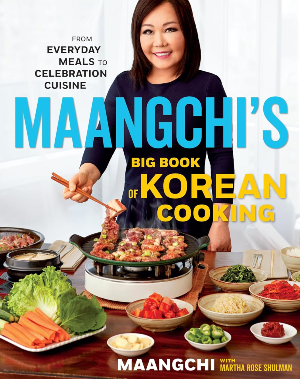
Why it's a beast: Maangchi's book is the perfect starting point for anyone looking to dive into Korean cooking. Her friendly, approachable style makes even complex dishes feel achievable. Plus, her online presence means you can often find video tutorials to complement the cookbook recipes.
What sets this cookbook apart is Maangchi's ability to break down complex techniques into manageable steps. For instance, her kimchi recipe doesn't just list ingredients and basic instructions. She explains the science behind fermentation, offers tips on how to tell when your kimchi is perfectly aged, and even suggests creative ways to use over-fermented kimchi (kimchi jjigae, anyone?).
Moreover, Maangchi doesn't shy away from lesser-known traditional dishes. Ever heard of sanchae bibimbap, a mountain vegetable bibimbap that's a specialty of Korea's mountainous Gangwon province? Or what about jjajangmyeon, a Korean-Chinese fusion noodle dish with a rich black bean sauce? Maangchi covers these and many more, offering a comprehensive look at the vast world of Korean cuisine.
But perhaps the most endearing aspect of this cookbook is how Maangchi infuses it with her personality. Her anecdotes about growing up in Korea, learning to cook from her mother and grandmother, and adapting Korean recipes in her American kitchen add a personal touch that makes you feel like you're cooking alongside a friend.
"Korean Home Cooking: Classic and Modern Recipes" by Sohui Kim and Rachel Wharton
Sohui Kim, the chef and owner of the acclaimed Brooklyn restaurant Insa, brings her culinary expertise to your home kitchen with this comprehensive cookbook. It's a beautiful blend of traditional recipes and modern interpretations that will satisfy both purists and adventurous eaters alike.
Key Features:
• Over 100 recipes, from classic banchan to restaurant-worthy main dishes
• In-depth exploration of Korean pantry staples
• Personal anecdotes that connect food with family and culture
• Techniques for achieving restaurant-quality results at home
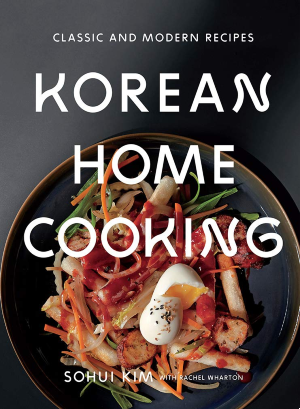
Why it's a beast: Kim's professional chef background shines through in the precision of her recipes. The book not only teaches you how to cook Korean food but also helps you understand the 'why' behind certain techniques, elevating your overall cooking skills.
What makes this cookbook stand out is Kim's ability to bridge the gap between home cooking and restaurant-quality dishes. For instance, her recipe for yangnyeom gangjeong (crispy fried chicken with a sweet and spicy sauce) includes chef's tips on how to achieve the perfect crispy coating that stays crunchy even after being coated in sauce – a technique that can elevate many other dishes in your culinary repertoire.
Kim also excels at demystifying some of the more complex Korean dishes. Her section on jjigae (Korean stews) is particularly noteworthy. She breaks down the basic formula for creating a well-balanced jjigae, then provides variations like kimchi jjigae, doenjang jjigae, and even a fusion-style budae jjigae (army base stew), allowing readers to understand the underlying principles and then get creative with their own combinations.
The cookbook also shines in its coverage of banchan, the small side dishes that are integral to Korean meals. Kim provides recipes for over 20 different banchan, from the ubiquitous kimchi to lesser-known dishes like musaengchae (spicy radish salad) and gaji namul (steamed eggplant side dish). She explains how to balance a meal with different banchan, considering textures, flavors, and colors.
"Koreatown: A Cookbook" by Deuki Hong and Matt Rodbard
Take a culinary tour of Koreatowns across America with this unique cookbook. Deuki Hong, a professional chef, and Matt Rodbard, a food writer, have created a book that's part cookbook, part travel guide, and entirely delicious.
Key Features:
• Over 100 recipes collected from Koreatowns across the United States
• Profiles of Korean-American chefs and food personalities
• Tips for drinking Korean-style (hint: it involves a lot of soju!)
• A comprehensive guide to Korean ingredients and kitchen tools
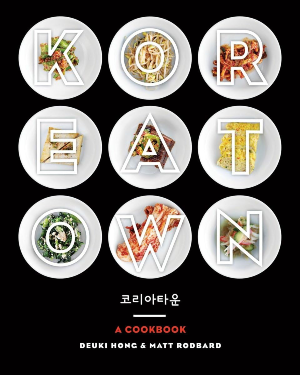
Why it's a beast: This book offers a fresh perspective on Korean cuisine through the lens of the Korean-American experience. It's as much a cultural exploration as it is a cookbook, perfect for those who want to understand the evolution of Korean food in America.
What sets "Koreatown" apart is its exploration of how Korean cuisine has adapted and evolved in the United States. The authors delve into the history of Koreatowns across America, from Los Angeles to New York, exploring how these communities have preserved their culinary traditions while also innovating and adapting to local tastes and ingredients.
The cookbook shines in its coverage of Korean-American fusion dishes. For instance, it includes a recipe for kimchi pasta, a dish that perfectly encapsulates the blending of Korean and American cuisines. The authors explain how such fusion dishes came to be, often born out of necessity when traditional Korean ingredients weren't readily available, or as a way to appeal to a broader American palate.
Another standout feature is the book's exploration of Korean drinking culture. The authors dive deep into the world of soju, makgeolli (Korean rice wine), and other Korean alcoholic beverages. They explain drinking etiquette (never pour your own drink!), offer recipes for anju (drinking snacks), and even include hangover cures for the morning after.
The profiles of Korean-American chefs and food personalities add depth to the cookbook, offering insights into how these individuals navigate between traditional Korean flavors and modern American cuisine. These stories provide context for the recipes and help readers understand the ongoing evolution of Korean-American food.
"Cook Korean!: A Comic Book with Recipes" by Robin Ha
Who says cookbooks have to be traditional? Robin Ha's innovative approach combines Korean recipes with charming comic-style illustrations, creating a cookbook that's as fun to read as it is to cook from.
Key Features:
• 64 recipes presented in a unique comic book format
• Easy-to-follow visual instructions perfect for beginners
• Playful and informative tidbits about Korean culture and food traditions
• A fresh, modern take on cookbook design
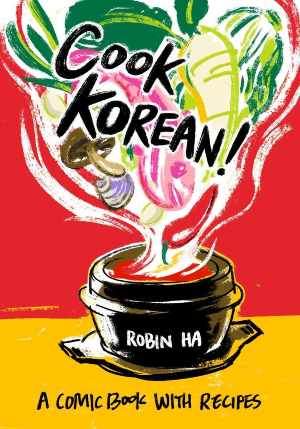
Why it's a beast: This cookbook breaks the mold with its creative presentation. The comic book format makes complex recipes feel less intimidating, and it's a great way to get kids interested in cooking Korean food. Plus, it's just plain fun!
What makes "Cook Korean!" stand out is its ability to make Korean cooking accessible and appealing to a wide audience, including those who might be intimidated by traditional cookbooks. The comic book format allows Ha to visually demonstrate cooking techniques in a way that's often clearer than written instructions alone.
For instance, the recipe for bibimbap isn't just a list of ingredients and steps. Through her illustrations, Ha shows exactly how to arrange the components in the bowl for the most visually appealing (and Instagram-worthy) result. She also demonstrates the proper way to mix everything together – a crucial step for enjoying bibimbap that's often overlooked in traditional recipes.
The cookbook also excels in its cultural explanations. Through her charming illustrations, Ha provides context for various Korean dishes. For example, in the section on tteokguk (rice cake soup), she explains the Korean tradition of eating this dish on New Year's Day and how it's believed to grant you an additional year of life. These cultural tidbits make the cooking experience richer and more meaningful.
Ha's artistic background shines through in her illustrated glossary of Korean ingredients. Instead of relying on potentially confusing written descriptions, she provides detailed drawings of various Korean vegetables, sauces, and pantry staples, making it easy for readers to identify these items in Asian grocery stores.
"Growing Up in a Korean Kitchen: A Cookbook" by Hi Soo Shin Hepinstall
For a deep dive into traditional Korean cuisine, look no further than Hi Soo Shin Hepinstall's lovingly crafted cookbook. Part memoir, part recipe collection, this book offers a glimpse into the heart of Korean home cooking.
Key Features:
• Over 250 authentic recipes passed down through generations
• Detailed information on Korean ingredients and cooking methods
• Personal stories that provide context for the recipes
• A focus on the rituals and traditions surrounding Korean meals
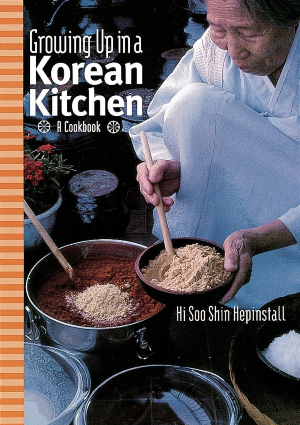
Why it's a beast: This cookbook is a treasure trove of traditional Korean recipes, many of which are hard to find in other English-language cookbooks. It's perfect for those who want to dive deep into the roots of Korean cuisine.
What sets "Growing Up in a Korean Kitchen" apart is its depth of traditional knowledge. Hepinstall doesn't just provide recipes; she offers a window into a way of life that's quickly disappearing in modern Korea. For instance, her section on kimchi doesn't just cover the common napa cabbage variety. She provides recipes for seasonal kimchi varieties that many Koreans made to preserve vegetables throughout the year, like dongchimi (radish water kimchi) for winter and oi sobagi (stuffed cucumber kimchi) for summer.
The cookbook shines in its coverage of Korean royal court cuisine, a style of cooking that's often overlooked in other Korean cookbooks. Hepinstall explains the principles behind royal court cuisine – its emphasis on presentation, the use of high-quality and rare ingredients, and the balance of colors and flavors in each dish. She provides recipes for dishes like gujeolpan (nine-sectioned platter) and sinseollo (royal hot pot), allowing home cooks to recreate these elaborate royal feasts.
Another standout feature of this cookbook is its exploration of Korean food philosophy. Hepinstall delves into the concept of Yak Sik Dong Won (food and medicine come from the same source), explaining how Koreans have traditionally used food for medicinal purposes. She provides recipes for dishes like samgye-tang (ginseng chicken soup) and explains their perceived health benefits.
The personal anecdotes scattered throughout the book add a rich layer of context to the recipes. Hepinstall's stories of growing up in Korea, learning to cook from her mother and grandmother, and the rituals surrounding food preparation and consumption provide readers with a deeper understanding of Korean food culture.
Best Korean Cookbooks for Modern and Fusion Cuisine
"My Korea: Traditional Flavors, Modern Recipes" by Hooni Kim
Michelin-starred chef Hooni Kim brings his unique perspective to Korean cuisine in this stunning cookbook. It's a perfect blend of traditional flavors and modern culinary techniques.
Key Features:
• 90 recipes that range from classic dishes to innovative creations
• Detailed explanations of Korean flavor profiles and cooking techniques
• Tips for sourcing and working with Korean ingredients
• Gorgeous photography that showcases the beauty of Korean food
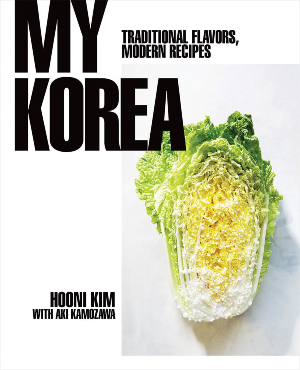
Why it's a beast: Kim's professional expertise shines through in this book. He breaks down complex flavor profiles and techniques in a way that home cooks can understand and replicate. It's a masterclass in elevating Korean cuisine to new heights.
What sets "My Korea" apart is Kim's ability to bridge the gap between traditional Korean flavors and modern culinary techniques. For instance, his recipe for bulgogi doesn't just stick to the classic preparation. He offers variations like bulgogi sliders and bulgogi nachos, showing how this beloved Korean dish can be adapted to different contexts while maintaining its essential flavors.
Kim's exploration of umami in Korean cuisine is particularly noteworthy. He dedicates an entire chapter to jang, the fermented soybean products that form the backbone of Korean flavors. He explains the differences between ganjang (soy sauce), doenjang (soybean paste), and gochujang (red chili paste), and provides recipes that showcase each of these ingredients.
The cookbook also excels in its coverage of banchan (side dishes). Kim elevates these small plates, traditionally seen as accompaniments, to star status. His recipe for mu muchim (daikon radish salad) transforms this simple side dish into a complex interplay of flavors and textures that could easily stand on its own.
Moreover, Kim's chef's tips scattered throughout the book provide invaluable insights for home cooks looking to elevate their Korean cooking. From how to achieve the perfect crispy skin on fish to the ideal way to slice meat for bulgogi, these tips help readers understand the 'why' behind cooking techniques.
"Korean American: Food That Tastes Like Home" by Eric Kim
New York Times staff writer Eric Kim offers a fresh take on Korean cuisine through the lens of his Korean-American upbringing. This cookbook is a delightful mix of traditional Korean flavors and American comfort food.
Key Features:
• 80 innovative recipes that blend Korean and American cuisines
• Personal essays that explore the Korean-American experience through food
• Adaptations of classic Korean dishes for modern American kitchens
• Tips for building a Korean-American pantry
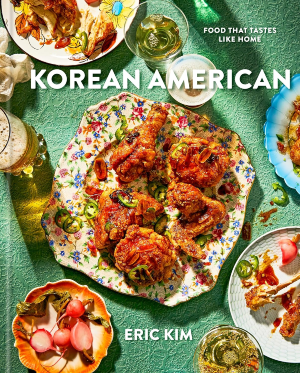
Why it's a beast: Kim's unique perspective offers a new way to approach Korean cooking. His recipes are perfect for those who want to explore Korean flavors but might be intimidated by strictly traditional recipes. Plus, his writing is warm and engaging, making this book a joy to read even when you're not cooking.
What makes "Korean American" stand out is its honest and personal approach to Korean-American cuisine. Kim doesn't shy away from using American ingredients in his Korean-inspired dishes. For instance, his recipe for kimchi jjigae (kimchi stew) includes a surprising ingredient: American cheese. He explains how this addition, while not traditional, adds a creamy richness that complements the spicy, tangy flavors of the stew.
The cookbook shines in its exploration of how Korean flavors can be incorporated into everyday American dishes. Kim's gochujang chocolate lava cakes and caramelized-kimchi baked potatoes are prime examples of how Korean ingredients can add depth and complexity to familiar Western recipes.
Kim's writing is another highlight of the book. His essays on growing up Korean-American in Atlanta, navigating between two cultures, and finding his identity through food are touching and relatable. These stories provide context for the recipes and help readers understand the emotional connections we all have with food.
The cookbook also includes a comprehensive guide to building a Korean-American pantry. Kim doesn't just list ingredients; he explains how to use them, suggests brands, and offers storage tips. This section is invaluable for those new to Korean cooking or those looking to expand their repertoire.
"Vegetarian Korean Food: Authentic Flavors in Simple Steps" by Shin Kim
As more people embrace plant-based diets, Shin Kim's cookbook offers a fresh take on Korean cuisine that doesn't rely on meat. It's proof that Korean food can be just as delicious without the bulgogi!
Key Features:
• Over 50 vegetarian and vegan Korean recipes
• Guidance on making plant-based versions of Korean staples
• Nutritional information for health-conscious cooks
• Tips for maintaining the depth of flavor in meatless Korean dishes

Why it's a beast: This cookbook fills a crucial niche in Korean cuisine. It's perfect for vegetarians, vegans, or anyone looking to incorporate more plant-based meals into their diet without sacrificing the bold flavors of Korean cooking.
What sets "Vegetarian Korean Food" apart is its innovative approach to traditionally meat-heavy Korean dishes. Kim doesn't just omit meat from recipes; she reimagines dishes to create satisfying vegetarian alternatives. For instance, her mushroom bulgogi uses a variety of mushrooms to mimic the texture and umami flavor of the traditional beef version.
The cookbook excels in its use of Korean temple cuisine as inspiration. Temple cuisine, developed by Buddhist monks, has been vegetarian for centuries. Kim draws on these traditions to create dishes like jangjorim (soy sauce braised tofu) and hobak jeon (zucchini pancakes) that are both authentic and plant-based.
Kim's exploration of fermented foods is another highlight. She provides recipes for various kimchi that don't rely on fish sauce or shrimp paste for depth of flavor. Her vegan kimchi recipe uses kelp powder and miso to create the complex, umami-rich taste that kimchi is known for.
The cookbook also stands out for its focus on nutrition. Each recipe includes a nutritional breakdown, making it easy for health-conscious cooks to incorporate these dishes into their meal plans. Kim also provides information on the health benefits of various Korean ingredients, from the antioxidant properties of gochugaru (red pepper flakes) to the digestive benefits of doenjang (fermented soybean paste).
Korean Cookbooks for Specific Dietary Needs
"The Korean Vegan Cookbook: Reflections and Recipes from Omma's Kitchen" by Joanne Lee Molinaro
Joanne Lee Molinaro, better known as The Korean Vegan, has taken social media by storm with her soulful recipes and storytelling. Her cookbook brings that same magic to the page, offering veganized versions of Korean classics alongside powerful personal narratives.
Key Features:
• Over 80 vegan Korean recipes, from basics to feast-worthy dishes
• Personal essays that connect food with family, culture, and identity
• Stunning photography that brings the recipes to life
• Tips for veganizing traditional Korean dishes

Why it's a beast: Molinaro's cookbook is more than just a collection of recipes – it's a deeply personal exploration of Korean-American identity through the lens of food. Her innovative approach to veganizing Korean classics is sure to inspire both vegans and omnivores alike.
What sets "The Korean Vegan Cookbook" apart is Molinaro's ability to capture the essence of Korean flavors in vegan form. Her tteokbokki (spicy rice cakes) recipe, for instance, uses a combination of gochugaru (red pepper flakes), gochujang (red pepper paste), and vegetable broth to create a sauce that's every bit as rich and complex as the traditional version made with anchovy stock.
The cookbook shines in its approach to typically meat-heavy dishes. Molinaro's bulgogi made with soy curls and her japchae (stir-fried glass noodles) with mushrooms and tofu demonstrate how plant-based ingredients can be used to create satisfying versions of these beloved dishes.
Molinaro's personal essays are another highlight of the book. She weaves stories of her family's immigration to America, her experiences growing up Korean-American, and her journey to veganism throughout the cookbook. These narratives provide context for the recipes and explore the complex relationships we have with food, culture, and identity.
The cookbook also excels in its coverage of Korean vegan banchan (side dishes). From kongnamul muchim (seasoned soybean sprouts) to gaji namul (steamed eggplant side dish), Molinaro provides a wide array of banchan recipes that are traditionally vegan or have been cleverly adapted.
"The Gluten-Free Asian Kitchen: Recipes for Noodles, Dumplings, Sauces, and More" by Laura B. Russell
While not exclusively focused on Korean cuisine, this cookbook includes a significant number of gluten-free Korean recipes and is an invaluable resource for those with gluten sensitivities who want to explore Asian cooking.
Key Features:
• Gluten-free adaptations of popular Asian dishes, including many Korean favorites
• A comprehensive guide to gluten-free Asian ingredients
• Tips for navigating Asian markets and identifying gluten-free products
• Recipes for gluten-free versions of Asian staples like soy sauce and hoisin sauce

Why it's a beast: For those with celiac disease or gluten sensitivity, this cookbook opens up a world of Asian cooking that might otherwise seem off-limits. The Korean recipes included are authentic in flavor while being completely gluten-free.
What makes "The Gluten-Free Asian Kitchen" stand out is its thorough approach to gluten-free Asian cooking. Russell doesn't just provide recipes; she offers a comprehensive education on how to approach Asian cuisines without gluten. Her guide to Asian ingredients is particularly valuable, helping readers understand which common Asian ingredients contain gluten and how to find or make gluten-free alternatives.
The cookbook excels in its Korean recipes. Russell's gluten-free versions of dishes like japchae (stir-fried glass noodles) and bibimbap maintain the authentic flavors of these Korean classics while being safe for those with gluten sensitivities. Her recipe for gluten-free gochujang (Korean red pepper paste) is a game-changer for those who thought this essential Korean ingredient was off-limits.
Russell's approach to traditionally wheat-based dishes is innovative. Her mandu (Korean dumplings) recipe uses a blend of rice flour and tapioca starch to create a wrapper that's pliable and delicious. Her gluten-free Korean fried chicken achieves the perfect crispy coating without a speck of wheat flour.
The cookbook also provides valuable information on how to dine out safely at Asian restaurants, including Korean establishments. Russell offers tips on what questions to ask and which dishes are most likely to be naturally gluten-free or easily adapted.
Essential Korean Ingredients to Stock Your Pantry
Now that you've got your beast Korean cookbooks, it's time to stock your pantry! Here's a list of must-have Korean ingredients that will have you cooking like a pro in no time:
- Gochugaru (Korean red pepper flakes): These sun-dried and coarsely ground red peppers are essential for kimchi and many other Korean dishes. They provide a deep, slightly sweet heat that's distinct from other chili flakes.
- Gochujang (Korean red pepper paste): This fermented paste made from red chili, glutinous rice, fermented soybeans, and salt is a cornerstone of Korean cooking. It adds a complex, spicy-sweet flavor to everything from bibimbap to marinades.
- Doenjang (Korean fermented soybean paste): Similar to Japanese miso but with a more intense flavor, doenjang is used in stews, sauces, and marinades. It adds a rich, savory depth to dishes.
- Soy Sauce: While not uniquely Korean, soy sauce is used extensively in Korean cooking. Look for a naturally brewed Korean or Japanese variety for the best flavor.
- Sesame Oil: This aromatic oil is often used as a finishing touch in Korean dishes. A little goes a long way in adding nutty flavor and aroma.
- Rice Vinegar: Used in marinades, dressings, and as a seasoning, rice vinegar adds a mild acidity to dishes.
- Mirim (Korean sweet rice wine): Similar to Japanese mirin, this sweet rice wine is used in marinades and sauces to add depth and balance flavors.
- Kimchi (various types): While you can make your own, having a jar of good-quality kimchi on hand is always useful. It can be eaten as a side dish or used as an ingredient in other dishes.
- Dried Kelp (Dasima): Used to make broth and add umami flavor to dishes.
- Dried Anchovies: Another umami powerhouse, these are often used to make broth.
- Sesame Seeds: Both white and black sesame seeds are used in Korean cooking, often as a garnish or in sauces.
- Perilla Seeds: These nutty, slightly minty seeds are used in some Korean dishes and teas.
- Korean Pear: Used in marinades to tenderize meat and add sweetness.
- Garlic: A staple in Korean cooking, garlic is used generously in many dishes.
- Ginger: Fresh ginger adds a spicy, aromatic note to many Korean dishes.
- Green Onions: Used both as an aromatic ingredient and a garnish.
- Korean Radish (Mu): This large white radish is used in kimchi, soups, and as a side dish.

Tips for sourcing hard-to-find items:
• Check out your local Asian or Korean grocery stores. Many cities now have H Mart or other Korean supermarket chains.
• Look for online Asian grocery retailers. Websites like Yamibuy or Amazon often stock Korean ingredients.
• Some mainstream supermarkets now have international sections with Korean ingredients.
• Consider joining a Korean food subscription box service for regular deliveries of authentic ingredients.
• Farmer's markets in areas with significant Korean populations often have vendors selling Korean produce and products.
Suggested substitutions for common ingredients:
• Can't find gochugaru? Use a mix of paprika and cayenne pepper (though it won't be quite the same). Aleppo pepper can also be a decent substitute.
• No doenjang? Miso paste can work in a pinch, though the flavor profile is different. Opt for a darker miso for a closer match.
• Korean radish can often be substituted with daikon radish.
• If you can't find Korean pear, Bosc pears can sometimes work as a substitute in marinades.
• Regular cucumbers can be used in place of Korean cucumbers, though they're more watery.
• If you can't find perilla leaves, a mix of mint and basil can provide a similar flavor profile in some dishes.
Remember, while substitutions can work, using authentic Korean ingredients will give you the most genuine flavors. It's worth the effort to source these items if you're serious about Korean cooking!
Mastering Korean Cooking Techniques
Korean cuisine isn't just about the ingredients – it's also about the techniques. Here's an overview of some key cooking methods you'll encounter in Korean cooking:
- Fermentation: The foundation of many Korean flavors, from kimchi to gochujang. It's a process that requires patience but yields incredible depth of flavor. Fermentation is used not just for preservation, but as a way to develop complex flavors and increase the nutritional value of foods.
- Grilling: Korean BBQ isn't just delicious – it's a social experience. Many Korean cookbooks will teach you how to achieve that perfect char on your bulgogi or galbi. The key is often in the marinade and the high heat of the grill.
- Stir-frying: Quick, high-heat cooking that's perfect for dishes like japchae (stir-fried glass noodles). The key to successful stir-frying is to have all your ingredients prepped before you start cooking, as the process goes quickly once you begin.
- Braising: Slow-cooking meats and vegetables in flavorful liquids is key to dishes like galbi-jjim (braised short ribs). This method allows tough cuts of meat to become tender and infused with flavor.
- Stone pot cooking: Used for dishes like dolsot bibimbap, where the stone pot creates a crispy layer of rice at the bottom. The stone pot is preheated before the ingredients are added, allowing for a sizzling presentation and that coveted crispy rice.
- Steaming: Used for dishes like galbi-jjim (steamed beef short ribs) and various types of jjim (steamed dishes). Steaming helps to retain the natural flavors and nutrients of the ingredients.
- Pickling: Beyond kimchi, Koreans pickle a variety of vegetables. Quick pickling is often used to make side dishes, while longer fermentation is used for more complex flavors.
- Soup and stew making: From light, clear soups (guk) to hearty stews (jjigae), Korean cuisine has a wide variety of liquid-based dishes. The key is often in creating a flavorful base or broth.

Tips for perfecting your kimchi-making skills:
- Use the freshest ingredients possible. The quality of your vegetables will directly impact the flavor of your kimchi.
- Don't be afraid of fermentation – embrace the process! Fermentation is what gives kimchi its complex flavor and probiotic benefits.
- Adjust the amount of gochugaru (red pepper flakes) to control the spice level. Remember, you can always add more heat, but you can't take it away.
- Be patient – good kimchi takes time to develop its flavors. Taste it regularly during the fermentation process to understand how the flavors evolve.
- Experiment with different vegetables beyond the classic napa cabbage. Radish, cucumber, and green onion kimchi are all delicious alternatives.
- Pay attention to temperature. Warmer temperatures will speed up fermentation, while cooler temperatures will slow it down.
- Use clean utensils and containers to avoid introducing unwanted bacteria.
- Don't forget to "burp" your kimchi jar during fermentation to release built-up gases.

Guide to achieving the perfect bibimbap crispy rice bottom:
- Use a well-seasoned stone pot or cast-iron skillet. The heavy bottom helps distribute heat evenly.
- Heat the pot until it's smoking hot before adding oil and rice. This ensures the rice will start crisping immediately.
- Spread the rice evenly and press it down gently. This helps create a uniform crispy layer.
- Let it cook undisturbed for several minutes until you hear a crackling sound. Resist the urge to stir!
- Once you hear the crackling, add your toppings and let it cook for a few more minutes.
- Serve immediately for maximum crispiness. The longer it sits, the softer the rice will become.
- When eating, scrape the crispy bits from the bottom and mix them into your bibimbap for a delightful textural contrast.
From Cookbook to Table: Tips for Success
Now that you're armed with beast Korean cookbooks and essential ingredients, here are some tips to ensure your Korean cooking adventures are a success:
How to plan your Korean meal:
- Start with rice as the base of your meal. In Korea, a meal isn't complete without bap (rice).
- Include a soup or stew. This could be anything from a light miyeok-guk (seaweed soup) to a hearty kimchi-jjigae (kimchi stew).
- Prepare a variety of banchan (side dishes). A typical Korean meal includes anywhere from 3 to 12 different banchan.
- Consider a main protein dish like bulgogi or dakgalbi. This isn't always necessary if you have a variety of banchan, but it's common in modern Korean meals.
- Don't forget the kimchi! No Korean meal is complete without it.
- Balance flavors and textures. Try to include something spicy, something mild, something crunchy, and something soft.
- Consider the season. Korean cuisine places a strong emphasis on seasonal eating.

Proper table setting for a Korean feast:
- Place a bowl of rice on the left and a bowl of soup on the right.
- Arrange various banchan in the center of the table for sharing. Traditionally, banchan is meant to be shared family-style.
- Provide individual plates for the main dish if serving one.
- Don't forget the utensils – chopsticks and a spoon for each person. In Korea, it's common to use both throughout the meal.
- Place water glasses on the right side of the setting.
- If serving alcoholic beverages like soju or makgeolli, provide small traditional cups.
Etiquette tips for enjoying Korean food:
- Wait for the eldest person at the table to start eating before you begin. This shows respect for elders, which is an important aspect of Korean culture.
- Use your spoon for rice and soup, chopsticks for everything else. Unlike in some other Asian cuisines, it's perfectly acceptable to lift your rice bowl in Korean dining.
- It's okay to lift your rice bowl, but not your soup bowl. The soup bowl should remain on the table.
- Don't stick your chopsticks upright in your rice – this resembles incense sticks at a funeral and is considered bad luck.
- Sharing is caring – Korean meals are often communal experiences. It's common to share dishes and even use your chopsticks to put food on others' plates (though in more formal settings, serving utensils may be provided).
- Try a little of everything. It's considered polite to at least taste all the dishes that are served.
- If you're drinking alcohol, it's customary to pour for others and not for yourself. Hold your cup with both hands when someone is pouring for you as a sign of respect.
- Slurping noodles is perfectly acceptable and even encouraged – it's seen as a sign that you're enjoying the food.
Understanding Korean Flavor Profiles:
To truly master Korean cooking, it's essential to understand the key flavor profiles that make this cuisine unique:
- Spicy (Maeun Mat): This heat comes primarily from gochugaru (red pepper flakes) and gochujang (red pepper paste). It's not just about heat, though – these ingredients also add depth and complexity.
- Savory/Umami (Gokun Mat): This deep, rich flavor is often achieved through fermented ingredients like doenjang (soybean paste) or naturally glutamate-rich ingredients like kelp and anchovies.
- Sour (Sin Mat): Sourness in Korean cuisine often comes from fermented foods like kimchi or vinegars. It adds brightness and helps balance rich or spicy flavors.
- Sweet (Dan Mat): Sweetness is often subtle in Korean cooking, coming from ingredients like Korean pear, honey, or sugar used in marinades or glazes.
- Bitter (Sseun Mat): While not as prominent as other flavors, bitterness adds complexity to dishes and often comes from ingredients like perilla leaves or certain wild mountain vegetables.
- Salty (Jjajan Mat): Achieved through ingredients like soy sauce, salt, or fermented seafood products like jeotgal.
Balancing these flavors is key to creating harmonious Korean dishes. Many Korean recipes aim to incorporate multiple flavor profiles for a complex and satisfying taste experience.
Conclusion
There you have it, food lovers – the beast Korean cookbooks to spice up your culinary adventures in 2024! From time-honored traditions to exciting modern fusions, these cookbooks offer a treasure trove of authentic recipes waiting to be explored. Whether you're mastering the art of kimchi-making, perfecting your bibimbap technique, or experimenting with Korean-American fusion, these books have got you covered.
Remember, the journey to mastering Korean cuisine is as rewarding as the destination. Each time you crack open one of these cookbooks, you're not just learning recipes – you're connecting with a rich culinary tradition that spans thousands of years. You're joining a global community of food lovers who have discovered the magic of Korean flavors. And most importantly, you're creating delicious memories that will last a lifetime.
Korean cuisine is more than just food – it's a reflection of history, culture, and community. As you explore these recipes, take time to appreciate the stories behind the dishes, the significance of certain ingredients, and the way food brings people together in Korean culture.
Don't be afraid to experiment and make these recipes your own. While tradition is important, cuisine is always evolving. Who knows? You might create the next great Korean-fusion dish!
So grab your chopsticks, fire up that stove, and let these incredible cookbooks be your guide to creating Korean feasts that will wow your taste buds and impress your guests. From the sizzle of bulgogi on the grill to the comforting warmth of a bowl of sundubu-jjigae, a world of flavor awaits you.
Ready to cook up a storm? Your Korean culinary odyssey starts now – happy cooking, and as they say in Korea, "Masitkke deuseyo!" (Enjoy your meal!)


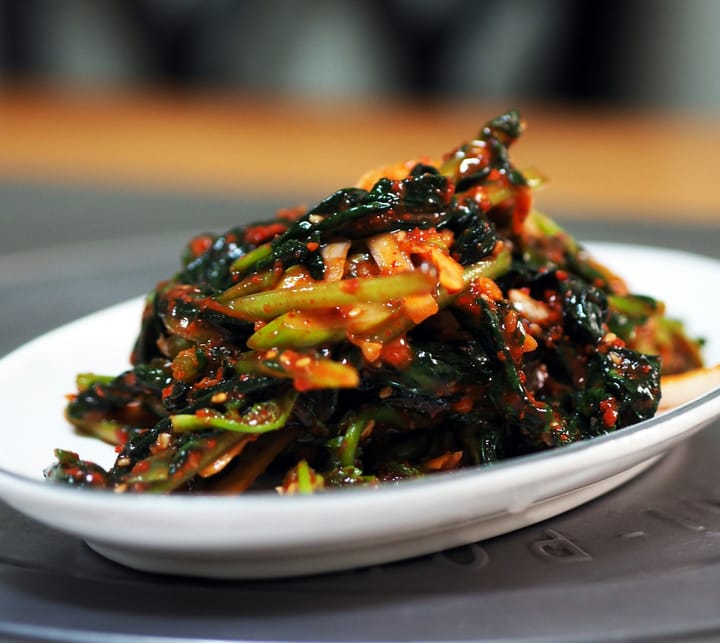
Comments ()